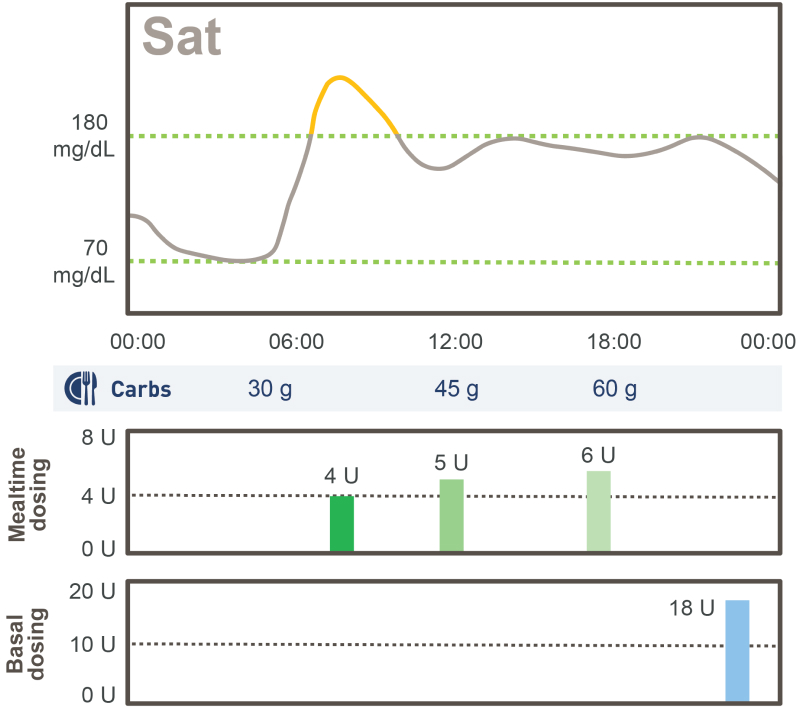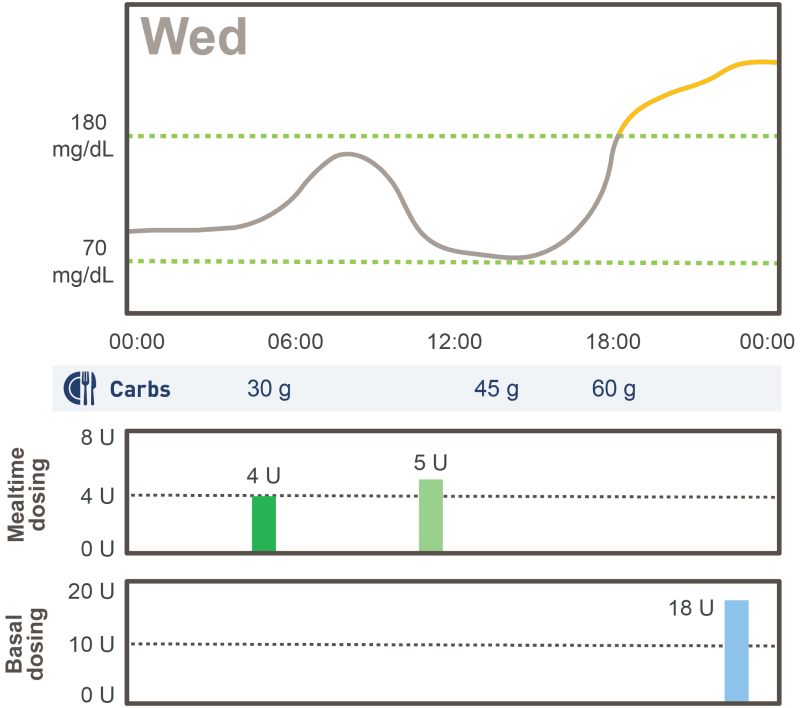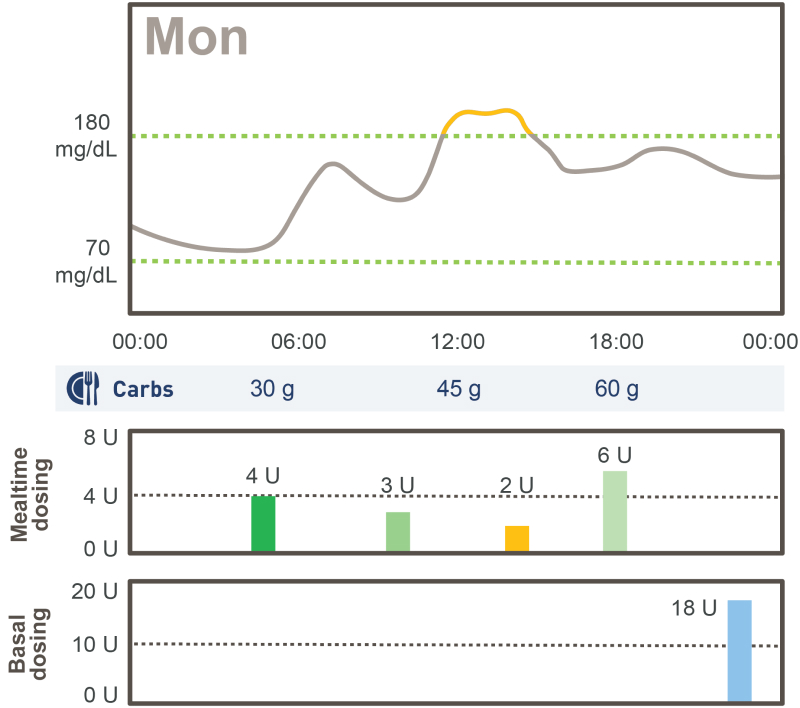Connected Insulin Pen (CIP) Toolkit
Value of Connected Insulin Pens (CIPs)
A CIP can facilitate insulin management for patients and providers by:
- Recording insulin doses in real time
- Accurately tracking insulin delivery
- Eliminating the need to manually log insulin doses and blood glucose readings
To see how a CIP not only connects insulin and glucose data but also the healthcare professional and patient, watch this animated module demonstrating how Franklin and his doctor used a CIP to uncover insulin dosing patterns that were not apparent with glucose data alone.
Meet Dr Lee and her patient, Franklin.
Franklin is 62 years old and was diagnosed with type 2 diabetes 11 years ago. Franklin has been on a basal insulin for 3 years now,
But 6 months ago, he and Dr Lee added a mealtime insulin to his regimen and started a continuous glucose monitor, or CGM, to help him achieve his glycemic goals.
Franklin is struggling with these changes and becoming frustrated about not reaching his glycemic goals. Dr Lee senses this.
Dr Lee: “Franklin, let’s look at your CGM results together and talk about what challenges you have been experiencing.”
To address Franklin’s challenges, they review his report from the last 2 weeks together.
She is very concerned about his instances of hypoglycemia. She can also see that Franklin’s glucose spends too much time above range and has a wide range of variability.
Dr Lee looks at Franklin’s day-to-day glucose graphs. She observes that his profiles vary each day, which could point to him facing multiple challenges when it comes to adjusting his insulin plan.
Dr. Lee discusses how there are numerous reasons for glycemic excursions, and being able to compare insulin doses with Franklin’s graphs would be very helpful to determine any trends that would indicate a need for dose changes.
Dr Lee: “I want to make sure that you’re getting the right insulin dose at the right time. But without a detailed log of your injections, I can’t make an informed decision.”
Franklin: “There’s just so much to keep up with, and recording my insulin feels like another chore.”
Dr Lee: “I realize it takes a lot of effort to manage your diabetes, but I have a solution that may work for you.”
Dr Lee: “A connected insulin pen, or CIP, can connect to your phone via Bluetooth to capture your insulin doses.
It logs the date and time of each injection, dose amount, and brand of insulin being used.
Some CIP apps also have built-in calculators to help you properly adjust your basal and mealtime insulin doses.”
Franklin: “Is this going to be one more app on my phone?”
Dr Lee: “A CIP is compatible with your CGM, so all of your diabetes data will be in one place.”
Dr Lee: “The report from your CIP will give me a clearer picture of what’s going on in your daily diabetes management and better inform our treatment decisions.”
Franklin: “It sounds like a CIP could really help!”
Dr Lee: “Good to see you! What do you think of the CIP?”
Franklin: “I've really liked it! Seeing the glucose and insulin data together has been really helpful.”
Dr Lee: “Do you think it has helped your glucose trends?”
Franklin: “I think it has!”
Dr Lee: “Let’s look at your report download and see!”
When Dr Lee reviews Franklin’s CIP report, she sees both CGM and insulin data from the last 2 weeks. It includes his average mealtime and basal dose amounts and timing.
Looking again at Franklin’s CIP logbook, adding insulin data allows Dr Lee to quickly identify patterns that may contribute to his glycemic variability.
Dr Lee: “I think there may be times when your dose was too low or given when your glucose was already rising. Let’s look and see how we can address any challenges you’re having.”
Dr Lee: “First, I’m concerned about this low glucose. Could you tell me about it?”
Franklin: “I remember that day because I got scared when I realized that I forgot to eat after taking my lunchtime dose. Sometimes I’m so busy and get distracted.”
Dr Lee: “That can happen. There are mealtime insulins where you no longer need to wait between injecting and eating, which could minimize this risk.”
Franklin: “I like the sound of that.”
Dr Lee: “I see that later this day you lowered your dinnertime mealtime dose, and your glucose levels rebounded above range for quite a while.”
Franklin: “I was nervous about my glucose dropping again.”
Dr Lee: “This is the type of situation where the calculator in your CIP app can help you safely adjust your dose to prevent that.”
Dr Lee: “Let’s look at your data from Saturday. Do you think you may have given your breakfast dose after you ate? See how your glucose was rising when you took your insulin.”
Franklin: “That’s exactly what happened! I was running late and forgot.”
Dr Lee: “That can happen to us all. But once your glucose levels rose above range, your regular doses weren’t enough to bring you back in range.
In your CIP app, you can set reminders to help.”
Franklin: “I see what you mean. I think reminders could help prevent me from forgetting to dose before I eat!”
Dr Lee: “Great!”
Dr Lee: “On Monday, it looks like your dinnertime dose may not have been enough, based on the spike that evening.”
Franklin: “I went out to a new restaurant. I wasn’t sure of the carbs in my meal since it was something I hadn’t had before. I figured it would be better to guess low rather than high. But once I realized my glucose was high, I did take another small dose!”
Dr Lee: “I see that! It’s great that you took a correction dose. Did you use your CIP’s dose calculator to decide on the amount?”
Franklin: “No...I just knew that 6 units was pretty normal for me, so I felt comfortable adding 2 more.”
Dr Lee: “That makes sense, but always know that the calculator is there and can help determine the accurate and safe dose. Your CIP app also has a carbohydrate database, and many restaurants publish their nutritional information. This can help with carb counting and determining the right dose.”
Dr Lee: “I think it would be a great idea to get you an appointment with a Certified Diabetes Care and Education Specialist, or CDCES. With your CIP data, I can see all the effort you’re putting into your diabetes management, which will help us fine-tune your doses. Working with the CDCES, you’ll be able to use your CIP to its full potential. I truly believe we will be able to make the right decisions and reach your glycemic goals.”
Franklin: “That sounds great!”
The insights provided by having both insulin and glucose data allowed Dr Lee to make informed changes to Franklin’s insulin plan, identify the areas where he needed extra support, and facilitate shared decision-making.
All of this contributes to the ability of CIPs to help identify suboptimal insulin dosing patterns including:

Mistimed doses
Continuous glucose monitor curve shows blood glucose above range from 6:00AM to 10:30AM. CIP report shows that patient did not administer their morning mealtime insulin until 7:30AM after eating breakfast.

Missed doses
Continuous glucose monitor curve shows blood glucose above range from 6:00PM to 12:00AM. CIP report shows that patient did not administer an evening mealtime insulin dose, even though they did eat dinner.

Inappropriate doses
Continuous glucose monitor curve shows blood glucose above range from 12:00PM to 4:00PM. CIP report shows that patient did not inject enough mealtime insulin for the carbohydrates in their lunch and later needed to add a corrective dose.
References
- Battelino T, Donne T, Bergenstal RM, et al. Clinical targets for continuous glucose monitoring data interpretation: recommendations from the International Consensus on Time in Range. Diabetes Care. 2019;42(8):1593-1603.
VV-MED-154647
Please rate your satisfaction with the content on the following statements:
Very Dissatisfied
Dissatisfied
Neutral
Satisfied
Very Satisfied